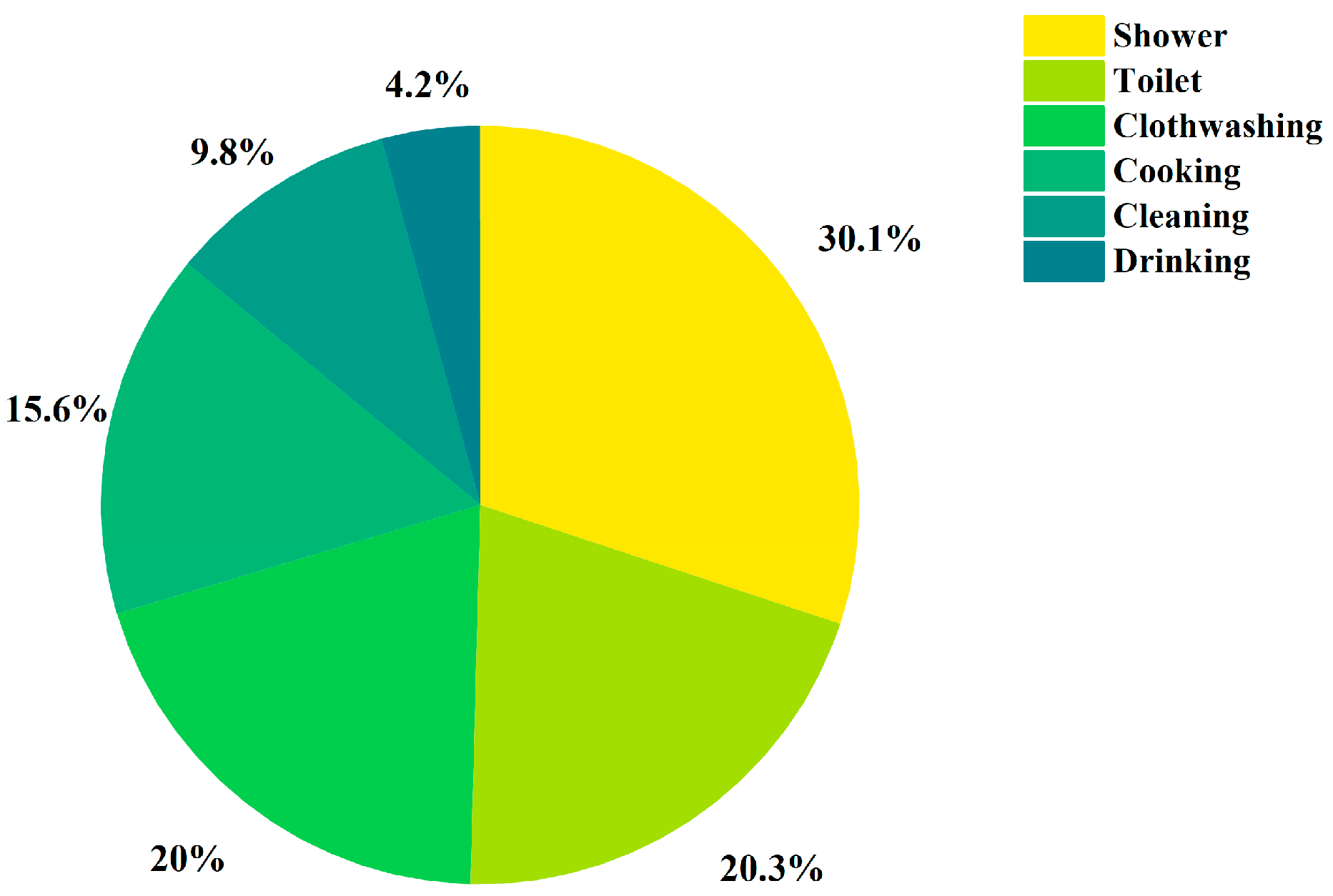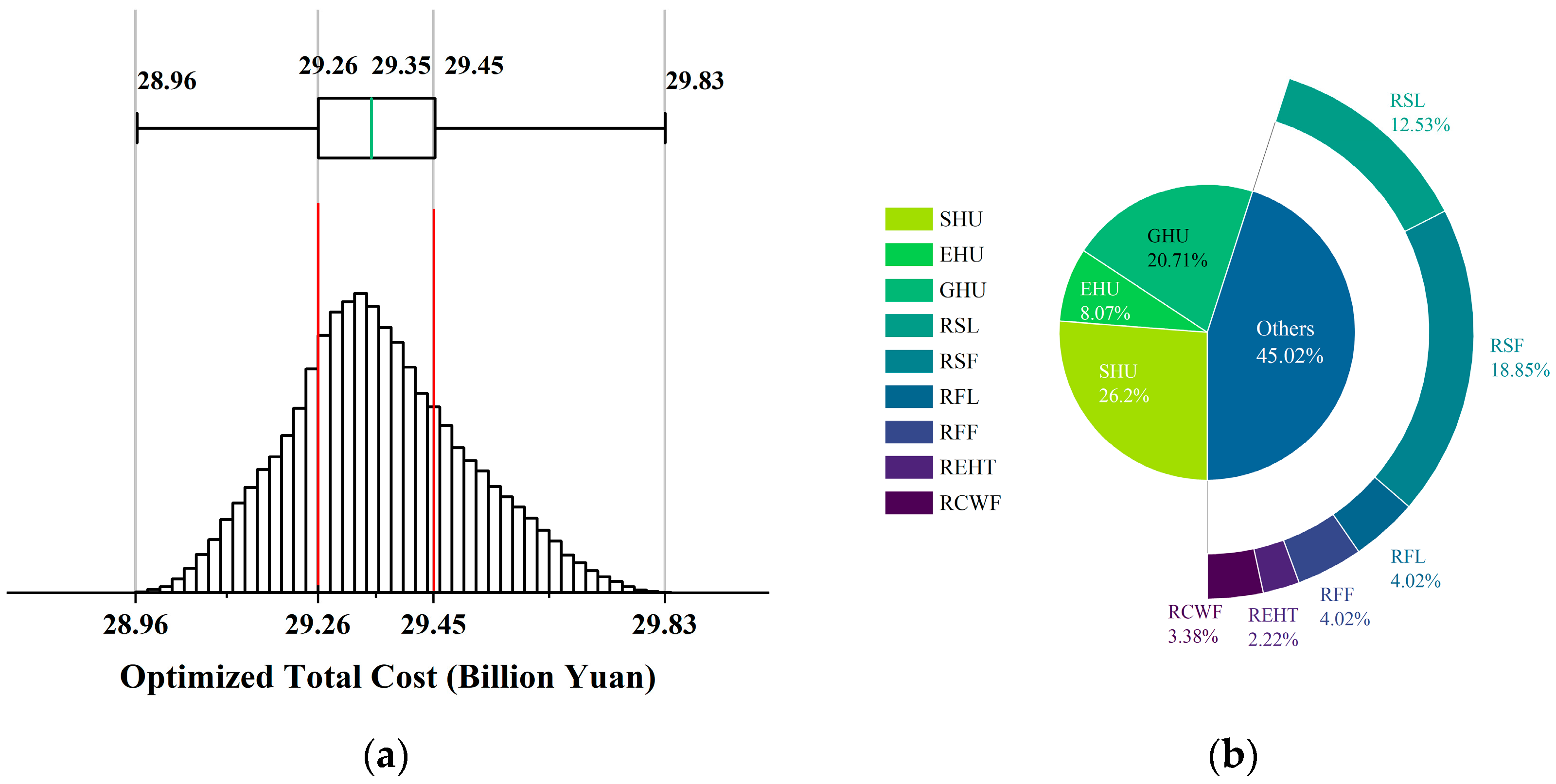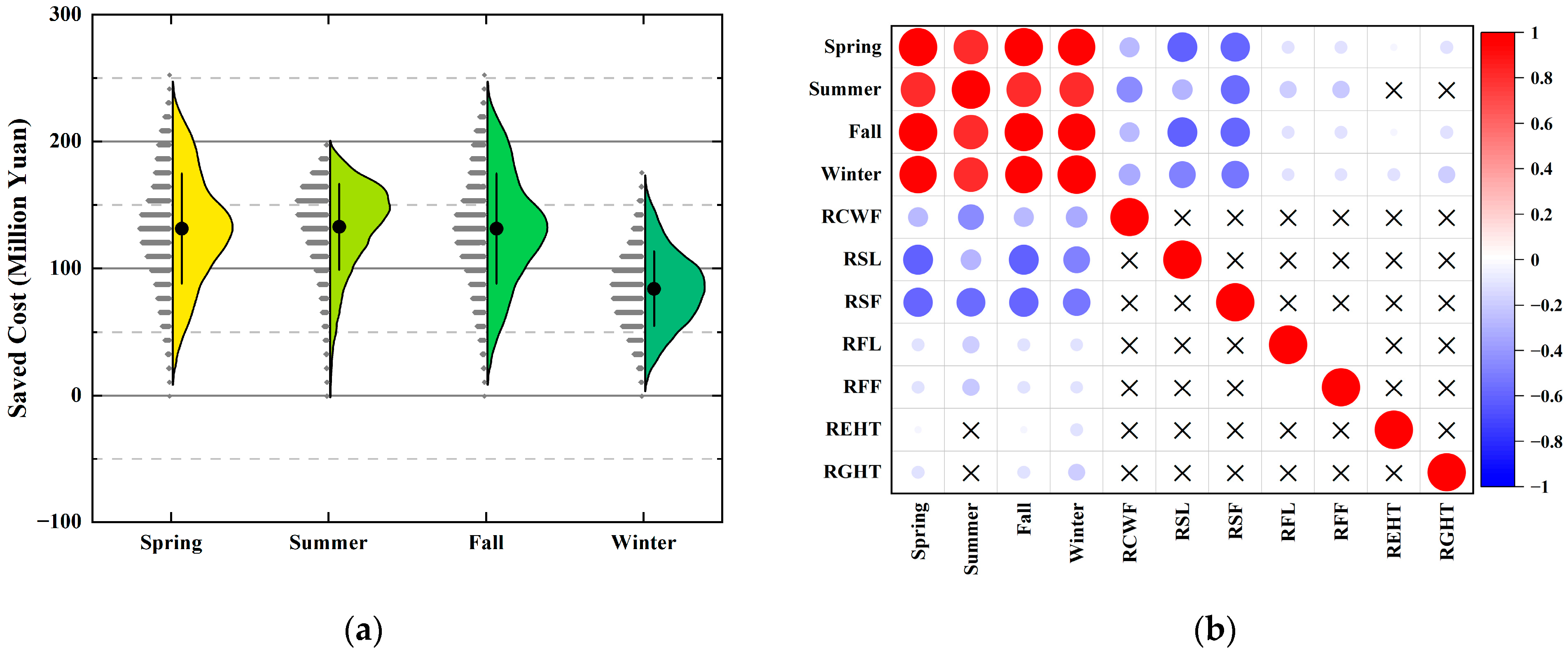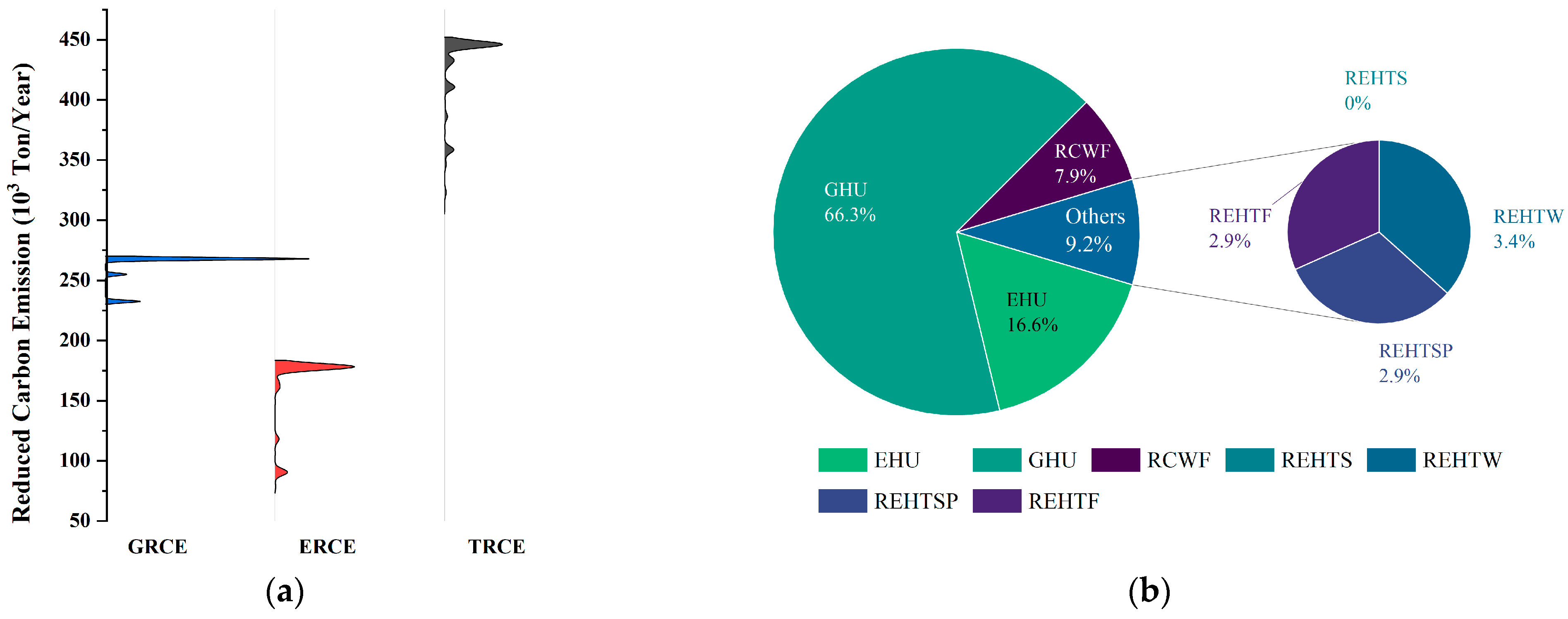Optimization of the Water–Energy–Carbon Nexus in the Residential Water Uses of Shanghai, China
Abstract
:1. Introduction
2. Materials and Methods
2.1. Study Area
2.2. Questionnaire Survey
2.3. Optimization Model
- (1)
- Objective function.
- (2)
- Constraints and supplementary equations.
3. Results and Discussion
3.1. Analysis of the Questionnaire Survey Data
3.2. Residential Water–Energy–Carbon Emission Optimization Results
3.2.1. Seasonal Factors
3.2.2. Carbon Emission Reduction
3.3. Potential Improvements in Future Research
- (1)
- Data collection. The questionnaire survey was conducted online due to the COVID-19 pandemic. Although the 496 valid sets of responses displayed reasonable heterogeneity and distribution across participated households in different districts, an offline survey with the same questionnaire may have broader coverage and diversity. For instance, Chongming District lacked a reliable sample size in current survey results, which potentially impacted the fidelity of the study results. In subsequent research endeavors, we hope to conduct offline surveys to augment sample size and widen the coverage of surveys, thereby enhancing the reliability and representativeness of research findings.
- (2)
- Water-saving awareness quantification. Subjective biases may be introduced into the survey data with respect to water-saving awareness. Alternative methods for quantifying water-saving awareness may be worth further exploration to enhance the reliability of quantified awareness parameters.
- (3)
- Factors influencing water and energy use. Seasonal factors were considered in this study; however, other factors that influence residential water and energy use, such as socioeconomic factors, geographical location, and the climate, require further analysis.
4. Conclusions
- (1)
- The survey data revealed that the intensities of water uses are higher in the central areas than suburb areas in Shanghai. At the household level, bathing, toilet flushing, and laundry are the top three water-using activities.
- (2)
- The water–energy–carbon nexus optimization model results showed an annual potential cost savings of CNY 149.42 per household in Shanghai, reflecting a 15.92% reduction in water cost, 7.22% reduction for gas cost, and 1.10% reduction for electricity cost. Overall, the long-term conservation measures were more effective than short-term ones. Water conservation was mostly effective for energy-saving, followed by saving gas and electricity. Specifically, showerhead upgrades led to the highest savings at 26.20%, followed by gas water heater upgrade at 20.71%. For short-term conservation behaviors, reducing shower frequency and duration accounted for 18.85% and 12.53% of energy saving, which were ranked third and fourth, respectively. Seasonal factors influenced the effectiveness of conservation efforts, with summer presenting the greatest opportunity for water and energy conservation at the household level.
Author Contributions
Funding
Institutional Review Board Statement
Informed Consent Statement
Data Availability Statement
Conflicts of Interest
Nomenclature
| Variable | Description, Unit |
| Z | Total cost of household water and energy consumption after conservation actions implemented, CNY. |
| Annual water expense, CNY. | |
| Annual energy expense, CNY. | |
| Annual water saving of Shanghai households, CNY/household. | |
| Original water use of Shanghai households, CNY/household. | |
| Water saving of short-term water conservation actions, CNY/household. | |
| Water saving of long-term water conservation actions, CNY/household. | |
| Annual energy saving of Shanghai households, kgce 1. | |
| Original energy use of Shanghai households, kgce. | |
| Energy saving of short-term energy conservation actions, kgce. | |
| Energy saving of long-term energy conservation actions, kgce. | |
| Reduced carbon emission associated with household water and energy uses by implementing conservation actions, kgCO2. | |
| Target of carbon emission reduction in Shanghai, kgCO2. | |
| Number of households taking short-term water conservation measures, household. | |
| Number of households taking short-term energy conservation measures, household. | |
| Number of households taking short-term water and energy conservation measures, household. | |
| Number of households taking long-term water conservation measures, household. | |
| Number of households taking long-term energy conservation measures, household. | |
| Number of households taking long-term water and energy conservation measures, household. | |
| Number of households taking short-term water conservation measures when certain long-term measures are conducted, household. | |
| Number of households taking short-term water conservation measures when certain long-term measures are not conducted, household. | |
| Number of households taking short-term energy conservation measures when certain long-term measures are conducted, household. | |
| Number of households taking short-term energy conservation measures when certain long-term measures are not conducted, household. | |
| Number of households taking short-term water and energy conservation measures when certain long-term measures are conducted, household. | |
| Number of households taking short-term energy conservation measures when certain long-term measures are not conducted, household. | |
| Parameter | Description, Unit |
| Unit cost of short-term water conservation actions, CNY/household. | |
| Unit cost of short-term energy conservation actions, CNY/household. | |
| Unit cost of short-term water and energy conservation actions, CNY/household. | |
| Unit cost of long-term water conservation actions, CNY/household. | |
| Unit cost of long-term energy conservation actions, CNY/household. | |
| Unit cost of long-term water–energy conservation actions, CNY/household. | |
| Unit water conservation efficiency of short-term water conservation actions, m3/household. | |
| Unit water conservation efficiency of short-term water and energy conservation actions, m3/household. | |
| Unit energy conservation efficiency of short-term energy conservation actions, kgce/household. | |
| Unit energy conservation efficiency of short-term water and energy conservation actions, kgce/household. | |
| Unit efficiency of short-term water conservation actions with certain long-term actions being implemented, m3/household. | |
| Unit efficiency of short-term water conservation actions without certain long-term actions being implemented, m3/household. | |
| Unit efficiency of short-term energy conservation actions with certain long-term actions being implemented, kgce/household. | |
| Unit efficiency of short-term energy conservation actions without certain long-term actions being implemented, kgce/household. | |
| Unit efficiency of short-term water and energy conservation actions with certain long-term actions being implemented, kgce/household. | |
| Unit efficiency of short-term water and energy conservation actions without certain long-term actions being implemented, kgce/household. | |
| Reduced carbon emission efficiency of long-term energy conservation actions, kgCO2/kwh or kgCO2/m3. | |
| Reduced carbon emission efficiency of long-term water and energy conservation actions, kgCO2/kwh or kgCO2/m3. | |
| Reduced carbon emission efficiency of short-term energy conservation actions, kgCO2/kwh or kgCO2/m3. | |
| Reduced carbon emission efficiency of short-term water and energy conservation actions, kgCO2/kwh or kgCO2/m3. | |
| 1 “kgce” means kilogram of coal equivalent (energy intensity). | |
References
- Lishan, Z. Analysis on the current situation and optimization countermeasures of water conservation management in residential quarters of Shanghai. Evironment Manag. 2020, 2, 209–210. [Google Scholar] [CrossRef]
- Escriva-Bou, A.; Lund, J.R.; Pulido-Velazquez, M.; Hui, R.; Medellín-Azuara, J. Developing a water-energy-GHG emissions modeling framework: Insights from an application to California’s water system. Environ. Model. Softw. 2018, 109, 54–65. [Google Scholar] [CrossRef]
- Scott, C.A.; Pierce, S.A.; Pasqualetti, M.J.; Jones, A.L.; Montz, B.E.; Hoover, J.H. Policy and institutional dimensions of the water-energy nexus. Energy Policy 2011, 39, 6622–6630. [Google Scholar] [CrossRef]
- Meng, F.; Liu, G.; Liang, S.; Su, M.; Yang, Z. Critical review of the energy-water-carbon nexus in cities. Energy 2019, 171, 1017–1032. [Google Scholar] [CrossRef]
- Hardy, L.; Garrido, A.; Juana, L. Evaluation of Spain’s water-energy nexus. Int. J. Water Resour. Dev. 2012, 28, 151–170. [Google Scholar] [CrossRef]
- Beal, C.D.; Bertone, E.; Stewart, R.A. Evaluating the energy and carbon reductions resulting from resource-efficient household stock. Energy Build. 2012, 55, 422–432. [Google Scholar] [CrossRef]
- Haseeb, M.; Kot, S.; Iqbal Hussain, H.; Kamarudin, F. The natural resources curse-economic growth hypotheses: Quantile–on–Quantile evidence from top Asian economies. J. Clean. Prod. 2021, 279, 123596. [Google Scholar] [CrossRef]
- Guan, D.; Hubacek, K. A new and integrated hydro-economic accounting and analytical framework for water resources: A case study for North China. J. Environ. Manag. 2008, 88, 1300–1313. [Google Scholar] [CrossRef] [PubMed]
- Griffiths-sattenspiel, B.; Wilson, W. The Carbon Footprint of Water. 2009. Available online: http://eec.ucdavis.edu/events/documents/water-energy_rivernetwork_carbon-footprint-of-water.pdf (accessed on 22 December 2021).
- Klein, G.; Krebs, M. California’ s Water–Energy Relationship Final Staff Report; Stanford University: Stanford, CA, USA, 2005. [Google Scholar]
- Vieira, A.S.; Beal, C.D.; Stewart, R.A. Residential water heaters in Brisbane, Australia: Thinking beyond technology selection to enhance energy efficiency and level of service. Energy Build. 2014, 82, 222–236. [Google Scholar] [CrossRef]
- Mazzoni, F.; Alvisi, S.; Blokker, M.; Buchberger, S.G.; Castelletti, A.; Cominola, A.; Gross, M.P.; Jacobs, H.E.; Mayer, P.; Steffelbauer, D.B.; et al. Investigating the characteristics of residential end uses of water: A worldwide review. Water Res. 2023, 230, 43–1354. [Google Scholar] [CrossRef]
- Chen, S.; Chen, B. Urban energy–water nexus: A network perspective. Appl. Energy 2016, 184, 905–914. [Google Scholar] [CrossRef]
- Kenway, S.J.; Lam, K.L. Quantifying and managing urban water-related energy use systemically: Case study lessons from Australia. Int. J. Water Resour. Dev. 2016, 32, 379–397. [Google Scholar] [CrossRef]
- Abdallah, A.M.; Rosenberg, D.E. Heterogeneous Residential Water and Energy Linkages and Implications for Conservation and Management. J. Water Resour. Plan. Manag. 2014, 140, 288–297. [Google Scholar] [CrossRef]
- Yu, M.; Wang, C.; Liu, Y.; Olsson, G.; Bai, H. Water and related electrical energy use in urban households—Influence of individual attributes in Beijing, China. Resour. Conserv. Recycl. 2018, 130, 190–199. [Google Scholar] [CrossRef]
- Arbués, F.; García-Valiñas, M.Á.; Martínez-Espiñeira, R. Estimation of residential water demand: A state-of-the-art review. J. Socio. Econ. 2003, 32, 81–102. [Google Scholar] [CrossRef]
- Zhou, Y.; Zhang, B.; Wang, H.; Bi, J. Drops of energy: Conserving urban water to reduce greenhouse gas emissions. Environ. Sci. Technol. 2013, 47, 10753–10761. [Google Scholar] [CrossRef] [PubMed]
- Escriva-Bou, A.; Lund, J.R.; Pulido-Velazquez, M. Optimal residential water conservation strategies considering related energy in California. Water Resour. Res. 2015, 51, 4482–4498. [Google Scholar] [CrossRef]
- Ren, Z.; Chan, W.Y.; Wang, X.; Anticev, J.; Cook, S.; Chen, D. An integrated approach to modelling end-use energy and water consumption of Australian households. Sustain. Cities Soc. 2016, 26, 344–353. [Google Scholar] [CrossRef]
- Byers, E.A.; Hall, J.W.; Amezaga, J.M. Electricity generation and cooling water use: UK pathways to 2050. Glob. Environ. Chang. 2014, 25, 16–30. [Google Scholar] [CrossRef]
- Venkatesh, G.; Chan, A.; Brattebø, H. Understanding the water-energy-carbon nexus in urban water utilities: Comparison of four city case studies and the relevant influencing factors. Energy 2014, 75, 153–166. [Google Scholar] [CrossRef]
- Escriva-Bou, A.; Lund, J.R.; Pulido-Velazquez, M. Saving Energy From Urban Water Demand Management. Water Resour. Res. 2018, 54, 4265–4276. [Google Scholar] [CrossRef]
- Wu, J.; Li, C.; Zhang, X.; Zhao, Y.; Liang, J.; Wang, Z. Seasonal variations and main influencing factors of the water cooling islands effect in Shenzhen. Ecol. Indic. 2020, 117, 106699. [Google Scholar] [CrossRef]
- Friedrich, E.; Pillay, S.; Buckley, C.A. Carbon footprint analysis for increasing water supply and sanitation in South Africa: A case study. J. Clean. Prod. 2009, 17, 1–12. [Google Scholar] [CrossRef]
- Zhang, H. Enlightenment of Low Carbon Electricity Consumption and Carbon Justice for Shenzhen Residents on Electricity Saving and Carbon Reduction in Shanghai. Shanghai Energy Sav. 2023, 10, 1400–1404. [Google Scholar] [CrossRef]








| Duration | Saving Type | Conservation Measure | Abbreviation |
|---|---|---|---|
| Long-term | Water | Showerhead upgrade 1 | SHU |
| Faucet upgrade | FU | ||
| Toilet upgrade | TU | ||
| Energy | Electric heater upgrade | EHU | |
| Gas heater upgrade | GHU | ||
| Water and Energy | Washing machine upgrade | WMU | |
| Dishwasher upgrade | DU | ||
| Short-term | Water | Reducing shower duration | RSD |
| Reducing shower frequency | RSF | ||
| Reducing faucet duration | RFD | ||
| Reducing faucet frequency | RFF | ||
| Energy | Lowering temperature of electric heater | RFHT | |
| Lowering temperature of gas heater | RGHT | ||
| Water and Energy | Reducing cloth washing frequency | RCWF |
| Short-Term Conservation Measure | a | b |
|---|---|---|
| Reducing shower duration | 14.48 | 2.13 |
| Reducing shower frequency | 14.96 | 2.20 |
| Reducing faucet duration | 14.00 | 2.07 |
| Reducing faucet frequency | 14.48 | 2.13 |
| Lowering temperature of electric heater | 14.59 | 2.15 |
| Lowering temperature of gas heater | 14.57 | 2.14 |
| Reducing cloth washing frequency | 13.49 | 1.96 |
| Municipal District | Number of Survey Participants | Monthly Water Fee (CNY) | Monthly Water Use (m3) |
|---|---|---|---|
| Minhang | 59 | 109.10 | 26.67 |
| Changning | 10 | 106.70 | 26.09 |
| Jing’an | 10 | 106.20 | 25.97 |
| Chongming | 2 | 105.50 | 25.79 |
| Putuo | 12 | 101.67 | 24.86 |
| Xuhui | 12 | 100.17 | 24.49 |
| Songjiang | 48 | 99.92 | 24.43 |
| Fengxian | 100 | 99.43 | 24.31 |
| Huangpu | 6 | 99.33 | 24.29 |
| Pudong | 132 | 98.01 | 23.96 |
| Qingpu | 27 | 97.00 | 23.72 |
| Jiading | 18 | 94.83 | 23.19 |
| Baoshan | 22 | 93.36 | 22.83 |
| Jinshan | 24 | 92.13 | 22.53 |
| Hongkou | 5 | 73.00 | 17.85 |
| Yangpu | 8 | 72.75 | 17.79 |
Disclaimer/Publisher’s Note: The statements, opinions and data contained in all publications are solely those of the individual author(s) and contributor(s) and not of MDPI and/or the editor(s). MDPI and/or the editor(s) disclaim responsibility for any injury to people or property resulting from any ideas, methods, instructions or products referred to in the content. |
© 2024 by the authors. Licensee MDPI, Basel, Switzerland. This article is an open access article distributed under the terms and conditions of the Creative Commons Attribution (CC BY) license (https://creativecommons.org/licenses/by/4.0/).
Share and Cite
Zhou, J.; Zhu, T. Optimization of the Water–Energy–Carbon Nexus in the Residential Water Uses of Shanghai, China. Sustainability 2024, 16, 3529. https://doi.org/10.3390/su16093529
Zhou J, Zhu T. Optimization of the Water–Energy–Carbon Nexus in the Residential Water Uses of Shanghai, China. Sustainability. 2024; 16(9):3529. https://doi.org/10.3390/su16093529
Chicago/Turabian StyleZhou, Jianyu, and Tingju Zhu. 2024. "Optimization of the Water–Energy–Carbon Nexus in the Residential Water Uses of Shanghai, China" Sustainability 16, no. 9: 3529. https://doi.org/10.3390/su16093529





